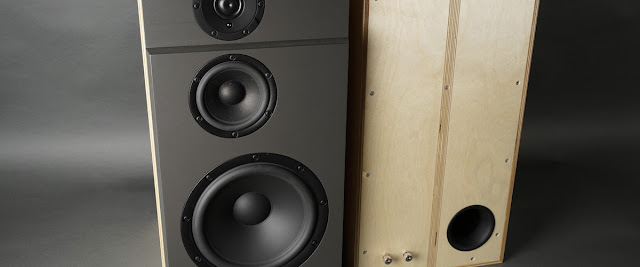The 3-Way Classic Part 5.
Next step was impedance measurements. I used REW for it and this is how the elements measured mounted in the cabinets.
SB21RDC-C000-4:
SB12MNRX25-4:SB23NRXS45-8:
I exported these curves from REW and imported them into VituixCAD.
Note: the following text has been altered since the post was first published. I had not fully understood the location parameters for the drivers in VituixCAD. Make sure you understand them and don't make the assumption that they represent the acoustic center like I did. It rendered all my previous simulations obsolete and it also forced me to go back, build a new measurement turntable and take new measurements.
Troels used second order Linkwitz-Riley filters at 600 Hz and 3700 Hz. This is what it would look like in VituixCAD using an active 2nd order LR filter at 600 Hz and a passive schoolbook 2nd order LR filter at 3700 Hz. I also added a resistor and a series notch filter on the tweeter and a Zobel filter on the mid-range. Note the buffers (amplifiers) positioned after the active filters. They are needed when mixing active and passive filters to get accurate impedance readings in the impedance graph.
Still a schoolbook filter at 3700 Hz but not bad at all. A bit weak below 1000 Hz maybe. Adding 2 dB gain to the active low-pass branch results in something quite flat. A simulated diffraction curve for the baffle step was included in the merge of the far field and near field measurements. Maybe a 2 dB room gain is just what is needed? It is otherwise quite easy to add 2 dB gain to the active low-pass or start off with a shelving low-pass at 383 Hz. This is what the latter would look like with a 3 dB gain.
It might be a bit too much, especially the hump around 60 Hz. But I don't know how much I can trust my near field measurements, the merge and the simulated baffle step loss. I think some room gain will be enough but it is easy to include an option for a shelving low pass in the active filter that can be utilized if room gain is not enough.
This is good enough for me to move on to the active filter. But a simulator like VituixCAD is great fun to play around with. No need for a huge bin with expensive XO parts. You can simply play around with all kind of crazy filters for free. Look at the following aliment for example. A first order low pass with a third order high pass...
This marks the end of the fifth part about my 3-Way Classics. The next post will be about the active filters...













